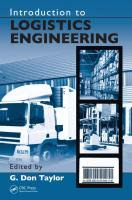- Hardcover: 320 pages
- Publisher: CRC Press; 1 edition (December 3, 2008)
- Language: English
- ISBN-10: 1420088513
- ISBN-13: 978-1420088519
Book Summary of Introduction To Logistics Engineering
Core Principles for Engineering Success with Logistics In spite of the growing recognition of logistics as a necessary condition for business success, there is a lack of introductory literature covering the field's technical aspects. Inspired by the bestselling "Logistics Engineering Handbook," this fundamental text provides an accessible point of entry into this critical discipline.
The author introduces topics, such facility layout and location, from a historical and economic viewpoint. His unique engineering-oriented approach focuses on material movement problems, introducing solution tools and metrics. Each chapter includes either a brief case study of an industrially motivated problem or a tutorial using fabricated data designed to highlight important issues. The book delves into activities that commonly fill the workday of logisticians, including inventory control, material handling systems, warehousing, distribution center, and transportation design. The book closes with an excellent chapter on logistics as an integrating systems function.
Written by leading experts in the field, this comprehensive, but brief, reference provides a solid foundation in the core principles of logistics engineering.
In spite its importance, logistics engineering often lags industry requirements, especially in terms of engineering-based needs. Filling the gap between education and practice, this brief but comprehensive volume covers the most basic material in the field of logistics engineering, making is suitable for those who require an overview of the topic. The book discusses logistics from historical and economic perspectives, covers the basic tools required for the study and practice of logistics, and reviews the metrics that can be used to evaluate progress. It then delves into activities that commonly fill the workdays of logisticians. The book closes with an excellent chapter on logistics as an integrating systems function.
The author introduces topics, such facility layout and location, from a historical and economic viewpoint. His unique engineering-oriented approach focuses on material movement problems, introducing solution tools and metrics. Each chapter includes either a brief case study of an industrially motivated problem or a tutorial using fabricated data designed to highlight important issues. The book delves into activities that commonly fill the workday of logisticians, including inventory control, material handling systems, warehousing, distribution center, and transportation design. The book closes with an excellent chapter on logistics as an integrating systems function.
Written by leading experts in the field, this comprehensive, but brief, reference provides a solid foundation in the core principles of logistics engineering.
In spite its importance, logistics engineering often lags industry requirements, especially in terms of engineering-based needs. Filling the gap between education and practice, this brief but comprehensive volume covers the most basic material in the field of logistics engineering, making is suitable for those who require an overview of the topic. The book discusses logistics from historical and economic perspectives, covers the basic tools required for the study and practice of logistics, and reviews the metrics that can be used to evaluate progress. It then delves into activities that commonly fill the workdays of logisticians. The book closes with an excellent chapter on logistics as an integrating systems function.
Download
